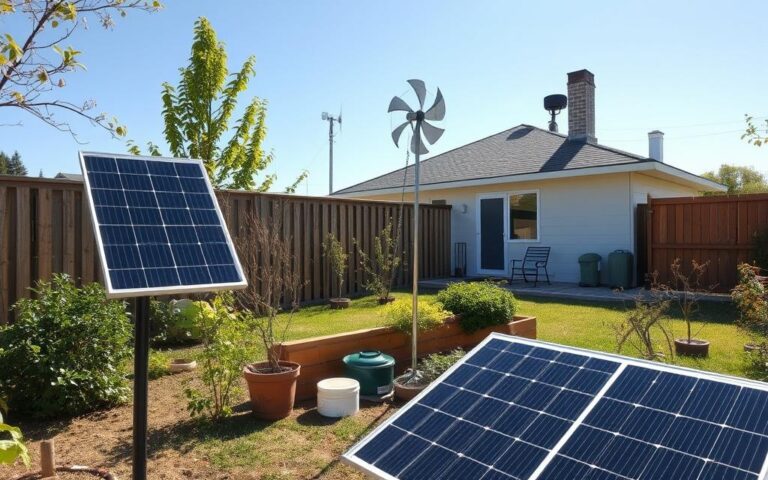
Renewable energy faces a big problem: 72% of solar and wind power is lost due to intermittency. Energy storage is the key to fixing this issue and boosting clean energy growth.
Storage tech helps make wind and solar power more reliable. It captures extra energy when production is high and releases it when it’s low. This solves the unpredictable nature of these energy sources.
Modern storage is changing our power grid. It helps renewable energy work better with the existing system. This makes our energy supply more stable and eco-friendly.
New storage methods are expanding renewable energy’s potential. These include advanced batteries and thermal systems. They’re solving intermittency issues and creating a cleaner energy future.
Understanding the Role of Energy Storage in Modern Power Grids
Electrical power generation is changing dramatically. Grid-scale storage tackles complex challenges in modern energy infrastructure. As renewable energy grows, sophisticated storage solutions become crucial.
Modern power grids face stability and reliability challenges. Renewable energy sources like wind and solar create unique demands. Intelligent energy management strategies are needed to address these issues.
The Evolution of Grid-Scale Storage Solutions
Energy storage technologies have advanced rapidly. They support load balancing and peak demand management. Key milestones include:
- Early mechanical storage systems
- Advanced battery technologies
- Sophisticated digital control mechanisms
- Decentralized energy storage networks
Addressing Peak Demand and Load Balancing
Load balancing is vital for grid stability. Grid-scale storage smooths out energy fluctuations. It stores excess energy during low-demand periods and releases it during peak times.
| Storage Technology | Peak Demand Capacity | Response Time |
|---|---|---|
| Lithium-Ion Batteries | 50-200 MW | Milliseconds |
| Pumped Hydro Storage | 1000-3000 MW | Minutes |
| Compressed Air | 100-500 MW | Seconds |
Integration with Renewable Energy Sources
Renewable energy integration is challenging due to intermittent generation. Advanced storage technologies bridge the gap between variable production and consistent demand. This ensures a stable and reliable power supply.
Grid-scale storage solutions transform the electrical grid. They create a more flexible, responsive, and sustainable system. Energy providers can now meet modern power needs efficiently.
Sustainable Energy Storage: Current Technologies and Applications
Sustainable storage technologies have transformed rapidly, offering innovative clean energy storage solutions. Modern energy systems need flexible and efficient storage methods. These support the growing renewable energy infrastructure.
Key sustainable energy storage technologies include:
- Advanced battery systems
- Mechanical energy storage
- Thermal storage solutions
- Compressed air energy storage
Energy storage is crucial for managing intermittent renewable sources like solar and wind. These technologies help stabilize power grids. They store excess energy during peak production and release it when demand is high.
Clean energy storage technologies fall into several innovative categories:
- Electrochemical Storage: Batteries that capture and release electrical energy
- Mechanical Storage: Systems using kinetic or potential energy
- Thermal Storage: Methods capturing and preserving heat energy
Advanced sustainable storage technologies are changing how we handle renewable energy. They provide grid flexibility and reduce carbon emissions. These solutions are key to creating a more sustainable energy ecosystem.
“The future of energy lies in our ability to store and manage renewable resources effectively.” – Energy Innovation Expert
Battery Technologies and Their Impact on Energy Storage
Battery innovations are reshaping the power landscape. They offer sophisticated solutions for grid-scale storage and renewable energy integration. These technologies are crucial in meeting the world’s growing electricity demands.
Modern batteries link sustainable energy production with reliable power distribution. Scientists constantly explore new ways to boost energy storage capabilities. Their work is vital for a greener future.
Lithium-Ion Battery Advancements
Lithium-ion batteries have revolutionized energy storage. Recent improvements have tackled their previous limitations. These advancements include better performance and safety features.
- Increased energy density
- Extended battery lifecycle
- Reduced manufacturing costs
- Enhanced safety features
Flow Batteries and Grid-Scale Applications
Flow batteries are pushing the boundaries of grid-scale storage. These innovative systems offer unique advantages for large-scale energy management. They provide solutions for utility-level power needs.
- Long-duration energy storage capabilities
- Scalable design for utility-level applications
- Potential for lower environmental impact
Emerging Battery Chemistry Innovations
Groundbreaking chemistry innovations are shaping the future of batteries. Scientists are exploring new materials and approaches. Solid-state batteries and advanced chemical compositions could transform energy storage.
The continuous evolution of battery technologies is key to achieving a sustainable and resilient energy infrastructure.
Battery chemistry innovations are advancing rapidly. These developments promise more efficient and sustainable energy solutions. Soon, we’ll have better ways to store and distribute renewable energy.
Mechanical Energy Storage Systems
Mechanical energy storage systems are vital for managing electrical grid stability. They capture and release energy through mechanical means. These systems offer unique advantages in large-scale power management.
Three main mechanical energy storage technologies exist in today’s energy landscape:
- Pumped hydro storage
- Compressed air energy storage
- Flywheel energy storage
Pumped hydro storage is the most established method. It uses gravity and water movement to generate electricity. Water is pumped to an elevated reservoir during low-demand periods.
When electricity demand rises, the water is released through turbines. This process generates substantial electrical power.
Compressed air energy storage is another fascinating approach. It stores energy by compressing air in underground caverns or special containers.
During peak demand, the compressed air is heated and expanded through turbines. This generates electricity with remarkable efficiency.
Flywheel energy storage is a cutting-edge mechanical solution. These systems store kinetic energy by spinning a rotor at high speeds.
When electricity is needed, the spinning rotor drives a generator. This quickly converts mechanical energy into electrical power. Modern flywheels can achieve remarkable energy conversion rates.
Mechanical energy storage technologies provide critical grid stabilization capabilities, bridging renewable energy intermittency challenges.
Each method offers unique benefits for grid operators and renewable energy providers. They can quickly respond to electrical demand changes. This makes them essential in modern power infrastructure.
Thermal Energy Storage Solutions
Thermal energy storage is a game-changer in sustainable power management. It captures and preserves heat from various sources. This technology offers solutions for energy intermittency and improves system efficiency.

Modern thermal storage systems use cutting-edge approaches to capture and store heat. They redistribute it across industrial and renewable energy applications. These technologies transform how we manage and use energy resources.
Molten Salt Storage Technology
Molten salt storage is revolutionizing concentrated solar power plants. This method allows power plants to store excess thermal energy during peak sunlight hours. It generates electricity during low-light periods and provides consistent power output.
Phase Change Materials in Energy Storage
These advanced materials can absorb, store, and release significant amounts of thermal energy during phase transitions. They have key applications in building temperature control and industrial heat management. Phase change materials also help stabilize renewable energy grids.
Industrial Heat Storage Applications
Industrial heat storage is boosting energy efficiency in manufacturing. It captures waste heat for later use. This technology helps industries cut energy consumption and operational costs.
Innovative thermal storage solutions are advancing sustainable power management. They pave the way for more resilient and efficient energy systems.
Hydrogen Storage and Fuel Cell Technology
Hydrogen energy storage offers a smart fix for renewable energy issues. It turns extra electricity into hydrogen through electrolysis. This creates a flexible and eco-friendly power storage method.
Power-to-gas storage brings many benefits to renewable energy. It can store energy for long periods and produces zero carbon emissions.
This method easily fits into current systems. It also packs more energy than regular batteries.
- Long-duration energy storage capabilities
- Zero carbon emissions during production
- Flexible integration with existing infrastructure
- High energy density compared to traditional batteries
Fuel cell technology plays a key role in hydrogen energy systems. These devices turn hydrogen straight into electricity. They provide efficient power for many industries.
| Storage Method | Energy Density | Efficiency |
|---|---|---|
| Compressed Hydrogen | 2.0 kWh/kg | 40-60% |
| Liquid Hydrogen | 2.5 kWh/kg | 50-70% |
| Metal Hydride Storage | 1.5 kWh/kg | 35-55% |
Transport and industry are using more hydrogen fuel cell tech. Electric vehicles, heavy machinery, and stationary power systems are seeing big advances in hydrogen energy.
Hydrogen represents the future of clean, sustainable energy storage and conversion.
Economic Implications of Energy Storage Implementation
Energy storage is changing fast due to new tech and smart investments. The global market is growing, making it vital to grasp the financial aspects.
Energy storage costs are dropping, making renewable energy more appealing. Investors see the potential of new storage solutions to change power systems.
Advanced storage could revolutionize our power infrastructure. This shift is attracting more attention from the investment community.
Cost Analysis of Storage Technologies
Different energy storage technologies have unique economic factors:
- Lithium-ion batteries: Rapidly decreasing costs
- Pumped hydro storage: High initial investment
- Flow batteries: Promising long-duration potential
Investment Trends and Market Growth
| Year | Global Investment ($B) | Market Growth Rate |
|---|---|---|
| 2020 | 12.5 | 15% |
| 2021 | 18.3 | 22% |
| 2022 | 25.7 | 30% |
Government Incentives and Policies
Government policies are boosting storage investment trends. Tax credits, grants, and new rules support energy storage growth.
These measures create a helpful environment for developing storage solutions. They encourage more companies to invest in this field.
“The future of energy lies in our ability to store and manage power efficiently” – Clean Energy Research Institute
New tech, lower costs, and helpful policies point to a bright future. Grid-scale energy storage solutions are set to transform our power systems.
Environmental Impact and Sustainability Considerations
Energy storage sustainability is now a key focus for researchers and environmental experts. Lifecycle analysis of storage tech shows complex environmental challenges. These issues must be addressed to create truly sustainable energy solutions.
Batteries’ environmental impact goes beyond their use. Raw material extraction and manufacturing processes pose significant ecological concerns. Careful management is needed to reduce their carbon footprint and potential environmental harm.
- Rare earth metal mining creates substantial ecological disruption
- Manufacturing processes generate considerable carbon emissions
- Recycling technologies are crucial for reducing waste
New approaches are improving energy storage sustainability. Researchers are developing innovative solutions to tackle these challenges.
- Circular economy strategies for battery materials
- Advanced recycling techniques
- Eco-friendly battery chemistries
The future of sustainable energy storage depends on comprehensive environmental strategies that balance technological innovation with ecological responsibility.
New tech is addressing storage lifecycle analysis. These solutions aim to reduce environmental impacts through better design and sustainable sourcing.
Advanced recycling processes are also part of these emerging technologies. They help minimize waste and promote resource efficiency in energy storage systems.
As renewable energy grows, storage’s environmental impact becomes crucial. Stakeholders must prioritize sustainable development for long-term ecological balance. This approach will help meet increasing energy demands responsibly.
Future Trends and Innovations in Energy Storage
Energy storage is changing fast, with new technologies pushing innovation boundaries. Next-gen batteries are set to change how we store and use electrical energy. These advancements promise to revolutionize our power systems.
Several key areas are driving advanced grid storage solutions:
- Solid-state battery technology
- Nanotechnology-enhanced energy storage
- Artificial intelligence-driven battery management
- Advanced materials for improved performance
Energy storage innovations are improving in important ways:
| Technology | Key Advantages | Potential Impact |
|---|---|---|
| Solid-State Batteries | Higher energy density | Enhanced electric vehicle range |
| Metal-Air Batteries | Lightweight design | Improved portable electronics |
| Flow Battery Chemistries | Long-duration storage | Grid stability improvement |
Nanotechnology is playing a crucial role in developing more efficient energy storage solutions. Scientists are studying tiny material structures to boost battery performance. These nanostructures could improve capacity and charging speeds significantly.
Energy storage’s future looks bright. New tech breakthroughs could transform renewable energy use. They may also improve grid resilience.
AI and advanced materials are opening doors. These tools could lead to more sustainable and efficient energy systems. The potential for positive change is enormous.
Conclusion: The Path Forward for Sustainable Energy Storage
Energy storage is crucial for a clean energy future. Advanced technologies are key to solving renewable energy challenges. Research in batteries, thermal storage, and hydrogen tech is vital.
Investing in storage infrastructure will transform power grids globally. New tech like solid-state batteries show great promise. They can change how we handle renewable energy.
These innovations offer better efficiency and lower carbon emissions. They also improve energy security for U.S. communities.
Teamwork between government, research, and tech firms is essential. This will speed up sustainable energy development. Policy support and funding are needed to drive the transition.
The future of energy storage demands innovation. It’s our best shot at fighting climate change. Advanced storage tech can build a sustainable energy system for future generations.
FAQ
What are the main types of energy storage technologies?
Energy storage technologies come in various forms. These include battery, mechanical, thermal, and hydrogen storage. Each type offers unique benefits for managing renewable energy and grid stability.
Battery storage uses lithium-ion and flow batteries. Mechanical storage includes pumped hydro and compressed air. Thermal storage uses molten salt and phase change materials.
Why is energy storage crucial for renewable energy?
Energy storage solves the intermittency issue of wind and solar power. It stores excess energy during peak production times. This stored energy is used when generation is low.
This process ensures a consistent and reliable power supply. It also balances grid loads and maximizes renewable energy potential.
How do lithium-ion batteries work in energy storage?
Lithium-ion batteries store energy through chemical reactions. These reactions move lithium ions between positive and negative electrodes. This happens during charging and discharging.
These batteries are popular due to their high energy density. They also have a long lifecycle and decreasing costs. This makes them valuable for grid-scale and portable energy storage.
What are the environmental considerations for energy storage technologies?
Environmental considerations cover the entire lifecycle of storage technologies. This includes raw material extraction, manufacturing, operation, and recycling. Energy storage supports renewable energy and reduces greenhouse gas emissions.
However, challenges exist in resource extraction and waste management. The environmental impact of battery production is also a concern.
How is hydrogen used in energy storage?
Hydrogen storage uses excess renewable electricity to produce hydrogen. This process is called electrolysis. The hydrogen can be stored for later use.
It can be converted back to electricity using fuel cells. It’s also used directly in industrial processes. This method provides flexible, long-duration storage and supports decarbonization efforts.
What are the economic challenges of implementing energy storage?
The main economic challenges are high initial capital costs. Varying technology maturity levels also pose a challenge. Continued research and development are needed.
However, technology costs are declining. Government incentives and increasing market demand are making energy storage more economically viable.
What emerging technologies are promising in energy storage?
Promising technologies include solid-state batteries and advanced flow battery chemistries. Metal-air batteries and nanotechnology innovations are also emerging. These aim to improve energy density and reduce costs.
They also enhance safety and extend the lifecycle of energy storage solutions.
How do thermal energy storage systems work?
Thermal energy storage systems capture and store heat or cold. Molten salt storage can store solar thermal energy. Phase change materials can regulate temperature in buildings.
These systems are useful in concentrated solar power plants. They’re also valuable in industrial applications where thermal management is critical.
What role do government policies play in energy storage development?
Government policies provide financial incentives, tax credits, and grants. They also create regulatory frameworks supporting grid modernization and renewable energy integration.
These policies help reduce investment risks. They stimulate innovation and speed up the adoption of energy storage technologies.
How does mechanical energy storage work?
Mechanical energy storage converts electrical energy into mechanical potential energy. It’s later reconverted to electricity. Examples include pumped hydro storage and compressed air energy storage.
Flywheel systems are another form of mechanical storage. These technologies provide large-scale, long-duration storage capabilities. They complement battery-based solutions well.




